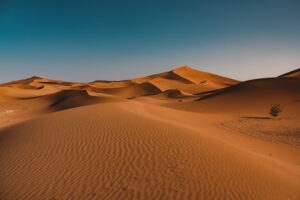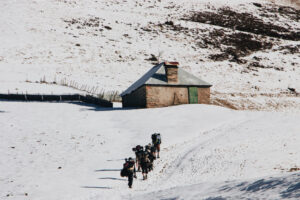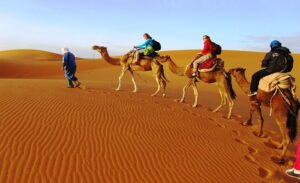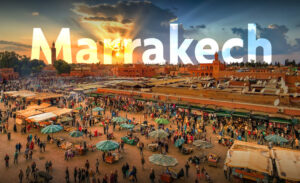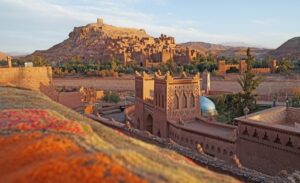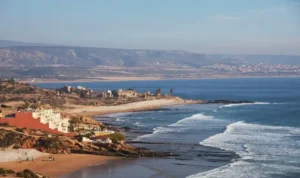The rich variety of the Animals of Morocco Sahara desert includes mostly unknown desert animals, from small reptiles to wild foxes, all of which will surprise and amaze visitors. If you are on a Sahara adventure, you can enjoy the wildlife in this harsh environment. Morocco Tourism Agency invites you to explore this uniquely diverse ecosystem with a private Sahara Desert tour from Marrakech.
Life in the Harsh Desert
One of the hottest deserts in the world, the Sahara, also has some of its largest dunes. Days are so scorching that people flee, while at night the temperature plunges to freezing again.
Yet there are still many animals that thrive here and make use of such a sparse environment. They have special skills to enable the animals to endure extreme heat and dryness: some burrow into sand, others are only active at night. Natre has provided them with the means of survival.
You can find these animals living along the length of the dunes, flat rocky lands, and the very rare green patches. Even a short walk with a local guide may bring a surprise. It is running before your eyes, a man wonders when he finds a bird pulled out of its height in the desert.
The Curious Fennec Fox

The most famous desert animal in the Sahara is also one of the smallest. With its large ears and small body, the fennec fox is easily recognizable by sight. It uses its big ears to avoid overheating and to catch prey underground–the newest animals for this kind of habitat. For insects, small rodents, and plants, keep the fennec alive.
Fennec foxes are active at night when it is cool. If you’re lucky, you may see their tracks in the sand early in the morning. Many visitors to Morocco are happy just to catch a chance to see this little animal during their desert trip there.
Reptiles and Insects of the Desert

The Sahara is a paradise for reptiles. Lizards, snakes, and geckos are everywhere. The sandfish is a lizard that burrows in sandy soil to escape heat and predators. Horned vipers blend so perfectly with the ground that they disappear. But if you happen to step on them, they’ll send a painful nudge into your feet. Yet, even these snakes are timid and unlikely to bite people at all.
Scorpions occupy the same ecosystem. The day is spent sheltering under rocks, and at night, they come out to feed. Under ultraviolet light, they glow. Though venomous, they sting only when stepped on or otherwise surprised. Desert ants and beetles scavenge dead material, thus serving to clean up the desert.
A Look at Birds in the Open Sky

Bird-watching in the Sahara can sometimes be as astonishing as walking through a forest. Migratory birds often pause in the desert during their long journey. One might see desert sparrows, desert larks, or even desert eagles flying across the sky. Owls hunt at night soundly and skillfully, using their sharply attuned hearing to hunt for food.
During camel treks, you may get to see the Pharaoh eagle-owl or the Desert wheatear. It is surprising how well these birds succeed in adapting themselves to life in arid spaces. Watching them fly over the dunes is a most beautiful sight to behold.
Mammals that Live in the Sahara

Apart from foxes, other mammals make their homes in this harsh, dry land. The jerboa is a small rodent that bounds along like a kangaroo. It stays underground by day and emerges from its burrows at night to feed on seeds. Although small in number, gazelles are also to be found. But they’re timid and won’t let anyone get near. Camels, of course, are most often seen. They carry people and goods across the desert, which makes life easier for everyone.
Camels are well-suited to life in hot desert areas. They can store fat in their hump, which provides energy when food is scarce. A lot of water can be drunk together at one time; they can go days without more. So camels are the monarchs of the Sahara.
Explore the Sahara’s Wildlife
Your best policy is to be driven around by a local guide who knows where they are. Combine guided tours with camel travel, good service, and other considerate ways of viewing wildlife, and it’s convenient indeed. Here at Morocco Tourism Agency, we work with skilled professionals who know the land and its animals well. While helping to protect nature itself, they can also show the desert’s original character to visitors in detail.
It’s a matter of patience because many animals are so shy. Bring binoculars, wear light clothes, and walk quietly. The best times to observe nature are dusk and dawn. Wilderness walks and camel treks are also great ways to find out more about the desert.
A Call to Protect Desert Wildlife
Morocco loves nature. That’s why a lot of effort is being put into protecting the Sahara’s animals. The life of the desert is fragile, and excessive human activity can harm it. If you travel with respect and care, you help safeguard this beauty for generations to come.
At Morocco Tourism Agency, we advocate for eco-friendly tourism. We help local communities, minimize waste, and care for the environment. One small step after another adds up to something big. When you book with us, you are helping Mother Nature and enjoying a genuine experience.
The Sahara of Morocco Awaits You
That the Sahara Desert of Morocco is a living place is beyond doubt. Every sound and track of it, every movement, tells tales. From tiny insects to birds that fly overhead, the desert is full of surprises. The place is unforgettable, whether you are a lover of nature or an adventurer by nature. You’ll remember it forever in your heart.
Morocco Tourism Agency is ready to make your next adventure. Learn about animals surviving against all odds. With skilled guides roaming at length the expanses of the desert and enjoying Morocco’s natural wonders, with our 4-day desert tour from Marrakech. The wild spirit of the Sahara beckons to you.





